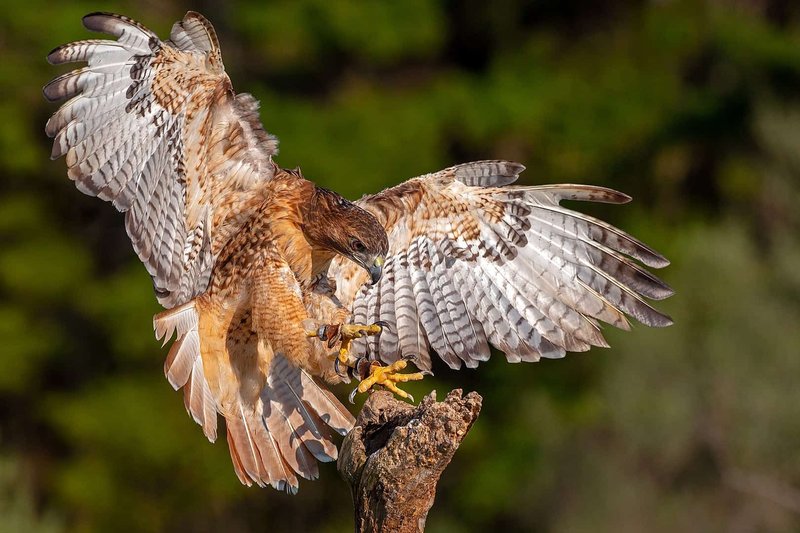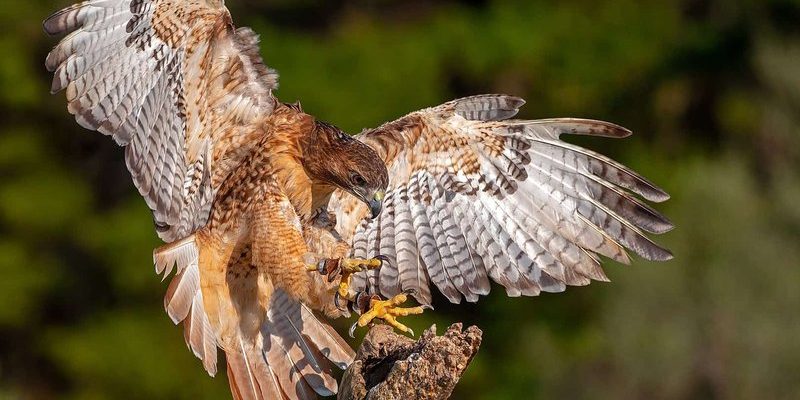
Whether you’re an avid birdwatcher or simply curious about wildlife, hawks have plenty to teach us. They embody the wild spirit of nature and exhibit behaviors that can leave us in awe. Let’s take a closer look and uncover some of the most intriguing facts about these remarkable birds.
1. Vision Like No Other
Hawks are known for their extraordinary vision. They can see up to eight times further than humans, making them exceptional hunters. Imagine looking through binoculars that magnify everything around you—this is how hawks perceive their world. Their eyes are specially adapted with a high density of photoreceptor cells, allowing them to detect colors and movements that we simply can’t see.
But it’s not just about far sight. Hawks can also see a wide range of colors, including ultraviolet light, which helps them spot prey more easily. This ability is kind of like having built-in night vision while also being able to see a full rainbow. So, when a hawk swoops down on its target, it’s not just luck; it’s a combination of incredible sight and skill.
2. Masters of the Sky
Ever seen a hawk soaring high above? They’re not just flying; they’re *effortlessly gliding*. Hawks use thermal updrafts—rising columns of warm air—to gain altitude without flapping their wings constantly. This means they can cover vast distances while conserving energy. Imagine you’re riding a giant invisible elevator; that’s essentially what a hawk is doing.
This flying technique allows hawks to conserve energy while also scanning the ground below for any signs of life. When they see a potential meal, they can quickly dive down with impressive speed and accuracy. It’s like having a front-row seat to a nature documentary every time you spot one in flight.
3. A Diverse Family
There are over 200 species of hawks around the world! From the small, agile sharp-shinned hawk to the powerful red-tailed hawk, each species has its own unique traits and hunting techniques. Some hawks prefer open fields, while others thrive in wooded areas or near water. This diversity is a testament to how well hawks have adapted to different environments.
For example, the *Cooper’s hawk* is known for its quick and agile flight, darting through trees to catch small birds. In contrast, the *Ferruginous hawk* prefers open grasslands and is one of the largest hawks in North America. Each species showcases the remarkable adaptability of these birds and their ability to thrive in various habitats.
4. Clever Hunters
Hawks are not just skilled flyers; they are also *strategic hunters*. They often survey their surroundings from high perches, allowing them to spot their prey from a distance. Once they’ve identified a target, they craft a plan based on the environment and the behavior of their prey.
For instance, a hawk may use stealth to sneak up on small rodents, waiting patiently until the right moment to launch a surprise attack. This calculated approach makes them effective predators. It’s like a game of chess, where they anticipate moves and make split-second decisions to secure their next meal.
5. Powerful Talons
A hawk’s talons are one of its most impressive features. These sharp, curved claws are designed for gripping and killing prey. When a hawk makes a kill, it uses its talons to pierce the flesh, showing just how powerful these birds really are.
In addition, a hawk’s grip is incredibly strong. They can apply significant pressure with their talons, ensuring that their prey doesn’t escape. If you’ve ever seen a hawk catch a mouse or a bird, you’ll understand the power and precision involved in the process. It’s a dramatic and effective method of survival in the wild.
6. Vocal Communicators
Hawks are not just silent observers; they are also vocal creatures. Each species has its own unique call, which can range from high-pitched whistles to more screech-like sounds. These calls serve various purposes, like attracting mates, marking territory, or warning others of danger.
Listening to a hawk’s call can be quite an experience. It carries through the air and often evokes a sense of wilderness. Imagine standing in a forest and hearing that sharp cry echoing around you; it’s a reminder of the untamed world that exists just outside our doors.
7. Migration Champions
Some hawk species are *long-distance migrators*, traveling thousands of miles between their breeding and wintering grounds. For example, the broad-winged hawk migrates from North America to Central America each year, covering impressive distances.
During migration, hawks often fly in large groups called “kettles,” which not only helps them conserve energy but also provides safety in numbers. Watching these kettles form in the sky is one of nature’s beautiful spectacles, as they showcase the incredible endurance and strength of these birds.
8. Cultural Significance
Hawks have held a special place in human culture for centuries. Many ancient civilizations revered them as symbols of power, wisdom, and freedom. In some cultures, they were even seen as messengers between the earth and the heavens.
Today, hawks continue to inspire art, literature, and folklore. They represent the wild spirit and resilience of nature, often serving as reminders of the importance of conservation. As we learn more about these incredible birds, we deepen our appreciation for the role they play in our ecosystems.
9. Conservation Status
While many hawk species are thriving, some face serious threats due to habitat loss, hunting, and environmental changes. It’s vital to protect their habitats and raise awareness about their importance in the ecosystem.
Organizations dedicated to wildlife conservation work tirelessly to ensure that hawks and other birds of prey can continue to flourish. Supporting these efforts is crucial for maintaining biodiversity and keeping these magnificent creatures in the skies for future generations to enjoy.
10. Fascinating Facts About Behavior
Hawks exhibit a range of fascinating behaviors. For instance, some species are known to engage in intricate courtship displays, flying in circles and performing dives to attract a mate. They also have strong family bonds, with parents often working together to raise their young.
Young hawks learn essential survival skills from their parents, such as hunting techniques and navigating the skies. This passing down of knowledge is vital for their development and ensures that the next generation is well-equipped for life in the wild.
In closing, hawks are truly remarkable creatures that captivate our attention and spark our curiosity. From their extraordinary vision to their clever hunting strategies, there’s so much more to these birds than meets the eye. By recognizing their significance and honoring their presence in our world, we can continue to appreciate and protect the incredible diversity of life that hawks represent.

